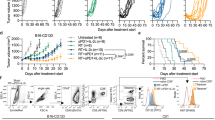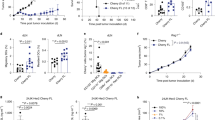Abstract
Despite the success of chemotherapy regimens in the treatment of acute lymphoblastic leukemia (ALL), certain subsets of patients have a high rate of induction failure and subsequent relapse. One of these subsets of patients carry a translocation between chromosomes 9 and 22, the so called Philadelphia chromosome (Ph+). The result of this translocation is the fusion oncogene, Bcr-Abl, which is uniquely expressed in the leukemia clone, and as such has the potential to initiate antileukemic immune responses against the leukemia blasts. We utilized a murine model of Ph+ ALL to look at the ability of systemic interleukin 12 (IL-12) treatments to initiate antileukemic immune responses, and studied the mechanisms by which it does so. We found that IL-12 was able to eliminate pre-established leukemia, and that this protection was mediated by CD4, CD8, and NK cells in combination. While IL-12 was able to eliminate pre-established leukemia, it did not elicit immunologic memory. Consistent with previous work, vaccination with irradiated leukemia cells transduced with immunomodulator genes was able to establish long-term memory, and, when used with IL-12, was able to eradicate pre-existing disease and induce resistance to subsequent leukemia challenge. These studies demonstrate the feasibility of an immunotherapeutic approach towards the treatment of Ph+ ALL.
This is a preview of subscription content, access via your institution
Access options
Subscribe to this journal
Receive 12 print issues and online access
$259.00 per year
only $21.58 per issue
Buy this article
- Purchase on Springer Link
- Instant access to full article PDF
Prices may be subject to local taxes which are calculated during checkout





Similar content being viewed by others
References
Niemeyer CM, Sallan SE . Acute lymphoblastic leukemia. In: Nathan DG, Oski FA, eds. Hematology of Infancy and Childhood. Philadelphia, PA: Saunders; 1998: 1249.
Uckun FM, Nachman JB, Sather HN, et al. Clinical significance of philadelphia chromosome positive pediatric acute lymphoblastic leukemia in the context of contemporary intensive therapies: a report from the Children's Cancer Group. Cancer. 1998;83:2030–2039.
Pui CH, Relling MV, Downing JR . Acute lymphoblastic leukemia. N Engl J Med. 2004;350:1535–1548.
Druker BJ, Sawyers CL, Kantarjian H, et al. Activity of a specific inhibitor of the BCR-ABL tyrosine kinase in the blast crisis of chronic myeloid leukemia and acute lymphoblastic leukemia with the Philadelphia chromosome. N Engl J Med. 2001;344:1038–1042.
Kwak LW . Approaches for immunotherapy of lymphomas. Immunol Invest. 2000;29:93–95.
Dranoff G . GM-CSF secreting melanoma vaccines. Oncogene. 2003;22:3188–3192.
Su Z, Dannull J, Heiser A, et al. Immunological and clinical responses in metastatic renal cancer patients vaccinated with tumor RNA-transfected dendritic cells. Cancer Res. 2003;63:2127–2133.
Stripecke R, Skelton DC, Gruber T, et al. Immune response to Philadelphia chromosome positive acute lymphoblastic leukemia induced by expression of CD80, interleukin 2, and granulocyte-macrophage-colony-stimulating factor. Hum Gene Ther. 1998;9:2049–2062.
Stripecke R, Skelton DC, Pattengale PK, Shimada H, Kohn DB . Combination of CD80 and granulocyte macrophage colony stimulating factor co-expression by a leukemia cell vaccine: preclinical studies in a murine model recapitulating Philadelphia chromosome positive acute lymphoblastic leukemia. Hum Gene Ther. 1999;10:2109–2122.
Gruber TA, Skelton DC, Kohn DB . Requirement for Natural Killer cells in CD40 ligand mediated rejection of Philadelphia chromosome positive acute lymphoblastic leukemia cells. J Immunol. 2002;168:73–80.
Trinchieri G . Interleukin-12 and the regulation of innate resistance and adaptive immunity. Nature. 2003;3:133–146.
Brunda MJ, Luistro L, Warrier RR, et al. Antitumor and antimetastatic activity of interleukin 12 against murine tumors. J Expr Med. 1993;178:1223–1230.
Cavallo F, Signorelli P, Giovarelli M, et al. Antitumor efficacy of adenocarcinoma cells engineered to produce interleukin 12 (IL-12) or other cytokines compared with exogenous IL-12. J Natl Cancer Inst. 1997;89:1049–1058.
Smyth MJ, Taniguchi M, Street SEA . The anti-tumor activity of IL-12: mechanisms of innate immunity that are model and dose dependent. J Immunol. 2000;165:2665–2670.
Dunussi-Joannopoulos K, Runyon K, Erickson J, Schau RG, Hawley RG, Leonard JP . Vaccines with interleukin 12-transduced acute myeloid leukemia cells elicit very potent therapeutic and long-lasting protective immunity. Blood. 1999;94:4263–4273.
Cui J, Shin T, Kawano T, et al. Requirement for Valpha14 NKT cells in IL-12-mediated rejection of tumors. Science. 1997;278:1623–1626.
Smiley ST, Kaplan MH, Grusby MJ . Immunoglobulin E production in the absence of interleukin-4-secreting CD1-dependent cells. Science. 1997;275:977–979.
Mascarenhas L, Stripecke R, Case SS, Xu D, Weinberg KI, Kohn DB . Gene Delivery to Human B-precursor acute lymphoblastic leukemia cells. Blood. 1998;92:3537–3545.
Stripecke R, Cardoso AA, Pepper KA, et al. Lentiviral vectors for efficient delivery of CD80 and granulocyte-macrophage-colony-stimulating factor in human acute lymphoblastic Leukemia and acute myeloid leukemia cells to induce antileukemic immune responses. Blood. 2000;96:1317–1326.
Acknowledgements
We thank Lora Barsky for assistance in flow cytometry and Fred Dorey, PhD for statistical analysis. This work was supported in part by the Kenneth T and Eileen J Norris Foundation.
Author information
Authors and Affiliations
Corresponding author
Rights and permissions
About this article
Cite this article
Gruber, T., Skelton, D. & Kohn, D. Recombinant murine interleukin-12 elicits potent antileukemic immune responses in a murine model of philadelphia chromosome-positive acute lymphoblastic leukemia. Cancer Gene Ther 12, 818–824 (2005). https://doi.org/10.1038/sj.cgt.7700839
Received:
Published:
Issue Date:
DOI: https://doi.org/10.1038/sj.cgt.7700839



